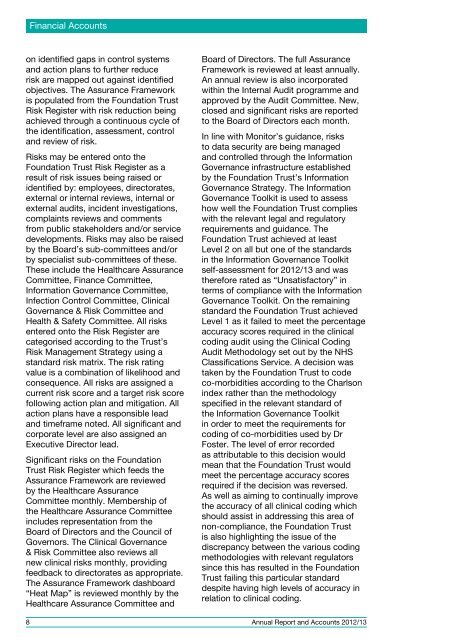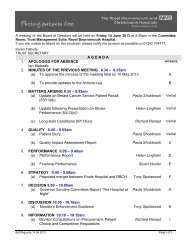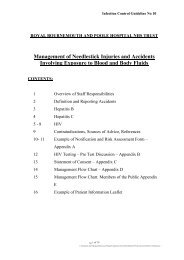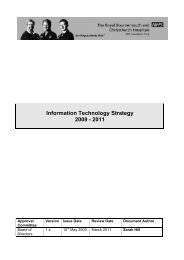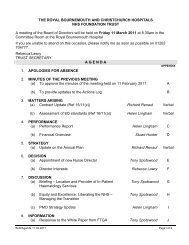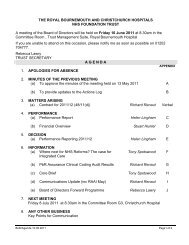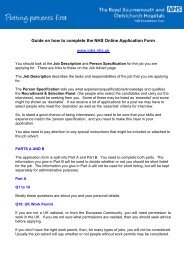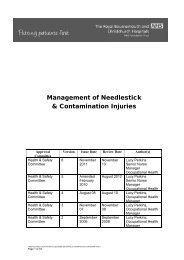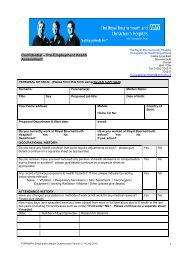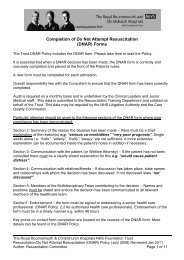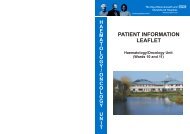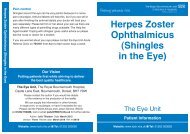Annual Report and Accounts 2012/13 - Royal Bournemouth Hospital
Annual Report and Accounts 2012/13 - Royal Bournemouth Hospital
Annual Report and Accounts 2012/13 - Royal Bournemouth Hospital
- No tags were found...
Create successful ePaper yourself
Turn your PDF publications into a flip-book with our unique Google optimized e-Paper software.
Financial <strong>Accounts</strong>on identified gaps in control systems<strong>and</strong> action plans to further reducerisk are mapped out against identifiedobjectives. The Assurance Frameworkis populated from the Foundation TrustRisk Register with risk reduction beingachieved through a continuous cycle ofthe identification, assessment, control<strong>and</strong> review of risk.Risks may be entered onto theFoundation Trust Risk Register as aresult of risk issues being raised oridentified by: employees, directorates,external or internal reviews, internal orexternal audits, incident investigations,complaints reviews <strong>and</strong> commentsfrom public stakeholders <strong>and</strong>/or servicedevelopments. Risks may also be raisedby the Board’s sub-committees <strong>and</strong>/orby specialist sub-committees of these.These include the Healthcare AssuranceCommittee, Finance Committee,Information Governance Committee,Infection Control Committee, ClinicalGovernance & Risk Committee <strong>and</strong>Health & Safety Committee. All risksentered onto the Risk Register arecategorised according to the Trust’sRisk Management Strategy using ast<strong>and</strong>ard risk matrix. The risk ratingvalue is a combination of likelihood <strong>and</strong>consequence. All risks are assigned acurrent risk score <strong>and</strong> a target risk scorefollowing action plan <strong>and</strong> mitigation. Allaction plans have a responsible lead<strong>and</strong> timeframe noted. All significant <strong>and</strong>corporate level are also assigned anExecutive Director lead.Significant risks on the FoundationTrust Risk Register which feeds theAssurance Framework are reviewedby the Healthcare AssuranceCommittee monthly. Membership ofthe Healthcare Assurance Committeeincludes representation from theBoard of Directors <strong>and</strong> the Council ofGovernors. The Clinical Governance& Risk Committee also reviews allnew clinical risks monthly, providingfeedback to directorates as appropriate.The Assurance Framework dashboard“Heat Map” is reviewed monthly by theHealthcare Assurance Committee <strong>and</strong>8Board of Directors. The full AssuranceFramework is reviewed at least annually.An annual review is also incorporatedwithin the Internal Audit programme <strong>and</strong>approved by the Audit Committee. New,closed <strong>and</strong> significant risks are reportedto the Board of Directors each month.In line with Monitor’s guidance, risksto data security are being managed<strong>and</strong> controlled through the InformationGovernance infrastructure establishedby the Foundation Trust’s InformationGovernance Strategy. The InformationGovernance Toolkit is used to assesshow well the Foundation Trust complieswith the relevant legal <strong>and</strong> regulatoryrequirements <strong>and</strong> guidance. TheFoundation Trust achieved at leastLevel 2 on all but one of the st<strong>and</strong>ardsin the Information Governance Toolkitself-assessment for <strong>2012</strong>/<strong>13</strong> <strong>and</strong> wastherefore rated as “Unsatisfactory” interms of compliance with the InformationGovernance Toolkit. On the remainingst<strong>and</strong>ard the Foundation Trust achievedLevel 1 as it failed to meet the percentageaccuracy scores required in the clinicalcoding audit using the Clinical CodingAudit Methodology set out by the NHSClassifications Service. A decision wastaken by the Foundation Trust to codeco-morbidities according to the Charlsonindex rather than the methodologyspecified in the relevant st<strong>and</strong>ard ofthe Information Governance Toolkitin order to meet the requirements forcoding of co-morbidities used by DrFoster. The level of error recordedas attributable to this decision wouldmean that the Foundation Trust wouldmeet the percentage accuracy scoresrequired if the decision was reversed.As well as aiming to continually improvethe accuracy of all clinical coding whichshould assist in addressing this area ofnon-compliance, the Foundation Trustis also highlighting the issue of thediscrepancy between the various codingmethodologies with relevant regulatorssince this has resulted in the FoundationTrust failing this particular st<strong>and</strong>arddespite having high levels of accuracy inrelation to clinical coding.<strong>Annual</strong> <strong>Report</strong> <strong>and</strong> <strong>Accounts</strong> <strong>2012</strong>/<strong>13</strong>


